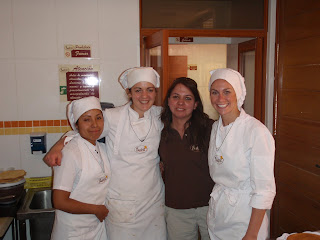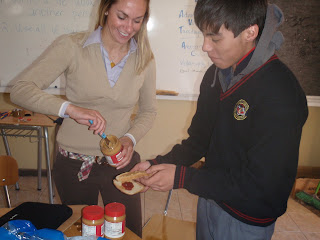Thursday…my favorite day of the week. My classes on Wednesday contain only bliss – the students listen, pay attention, and (overall) like me. This does not hold true for other days. Somehow, every Wednesday the universe knows I need a hug followed by a Thursday of reflection. I only teach one class on Thursdays at 8 am. Now that my schedule seems to be a bit more set, I’m relishing the time to absorb, prepare, and relax.
It’s now 11:11 am…time to break out a Quaker Sabor a Mousse de Chocolate bar (a treat Kat gave me yesterday). Imagine a Quaker Chewy Granola bar…but even more coated in sugar. I take a minute to read the label…it must be a foreign company because there is a %VD – Valores Diarios. I never realized how much I rely on the marketing teams of each food company to inform me of what percent of fat, protein, etc I need each day. Clearly, I’m incapable of doing to the math myself. I never look at actual fat count – I only look at the percent. In Chile, they do not include such percents. I’ve been trying to flex my nutritional knowledge to judge just how much saturated fat I should consume each day. I’m happy to read “sin grasas trans” on the label. Speaking of gras, Bob would be pleased to know they call calories here: energia. Every time I see the word, I can hear his voice saying: a calorie is only a measure of energy…isn’t more energy good?
My class finished at 9:30 this morning. I spent an extra hour guarding two cell phones for my students (they were in gym class, saw me, and asked me to watch them) and chatting with Meri on Gmail. Meri introduced me to the program in Chile and just returned to the corporate life in DC.
After my computer time, I walked a few blocks from school to pick up the D bus. I can take the D and X buses home. I usually take the X, but the D arrived first. I tried to take every part of the bus into my memories. I sometimes fear that I won’t remember my daily routines here. With the sudden need to record more, I took out my notebook and jotted a few things down…
My two bus rides each day occupy about 40 minutes (20 minutes each way), depending on how many stops. In the morning, I take the time to talk with Rodrigo. In the afternoon, I people watch. The buses are old, but neat…not clean. Trash seems to escape the interior cavities. This particular bus has green vinyl seats, which are mostly ripped and tattered. All of the buses have cloth curtains to block the sun. The windows remain shut – I assume to keep out the dust. The cost is 400 pesos during the day and only 100 pesos for students. 500 pesos = 1 US dollar. The drivers are all Chileans and usually friendly. Bus stops do not exist – you simply wait along side of the road (on one of the routes) to get on the bus and stand to alert the driver when you want to get off. The buses jerk and sway with each change of gear and bump in the road. The roads are mostly paved in Calama. Drivers easily make new roads though in certain areas where the ground is flat. Pot holes are enormous here. More dangerous for bikers than cars. Drivers often swerve to the opposing lane of traffic to avoid the large divots in the road. As I approach my house, I realize that I’ve finally learned the roads and know exactly where I live. For the first month, it was always a gamble knowing when and where to get off the bus.
Now that I’m at my computer, my thoughts drift back to my conversation with Meri. She enjoys her return to 8 hours of computer work, Starbucks…a paycheck, etc; however, she also misses the life here. Routine and customs truly are different in Chile. At first glance, I saw many similarities. With extra time to observe and live the culture, I see more variations in lifestyles. Here are a few…
Littering – putting trash in a can is not common. It’s more common to eat a candy and toss the wrapper, wherever you may be. When my students leave my classroom – it looks like I haven’t swept in weeks. Papers, pen pieces, wrappers, tissues cover the floor. The same applies for the streets and public areas.
Coffee and Milk - both are powdered/instant here.
Time and Scheduling – time really does not have much weight here. Most meetings, classes, and functions start late. For example, students won’t come to class until 10 or 15 minutes after the bell…the same applies for teachers. No one seems to keep a planner or schedule…its simply unnecessary. Plans change too often and seem to occur only days or minutes in advance. This has its positives and negatives – it’s nice not to have every minute devoted to some sort of task planned weeks in advance. It only becomes an issue when trying to plan something such as a vacation or event that requires more preparation. All of the volunteers are learning to let go of their sense of urgency. Set dates and times are a thing of the past...for now.
Celebrations – building from the idea of scheduling, celebrations seem to be much more relaxed here. While we would spend days preparing for an event (Christmas, July 4th), Chileans do not. On September 18th (their equivalent to July 4th), the volunteers woke up and burst onto the streets to find…not much. Barbeques, a community party, and sporadic parades during the days following the holiday summed up the celebration. It was enjoyable experiencing a holiday without the stress. Celebrations seem to be much more low-key here. I assume that it ties into not having a culture of planning ahead of time.
Food Diversity – in the States, each month seems to have a different food focus. In October, we eat/drink spiced cakes, pumpkins, cider, and German beers. In July, we dine on watermelon, corn, lemonade, and hamburgers. In January, we curl up with hot chocolate, stews, and mashed potatoes. Different regions of the US have their own specialties – in Arizona and California, Mexican food dominates – New England feeds us fresh seafood and clam chowder – the South dishes up fried chicken, corn bread, and sweet tea. For as large and diverse as Chile’s landscapes are…its food is not. Empanadas (pino and queso), pressured cooked chicken and rice, cazuela (a beef soup with large pieces of vegetables), a bean soup with spaghetti noodles (I forget the name…), churrasco (thinly sliced beef), pan (three types of white bread – round, square, and French), manjar (the most popular spread here – dulce de leche – used on everything from crackers to cakes), and berlins (cream filled pastry) can be found in any city during any season. I’ve learned how to make pastel de choclo (a corn dish with the Pino empanada filling) and hope to learn how to make empanadas soon. I plan on having a Chilean feast once I get back – you will be able to try all of the favorites here in one sitting! I enjoy the food here…it just surprises me that there isn’t more variation.
I started to miss home a little bit during the last two weeks…food poisoning and busted toes will do that to people. This week, I’ve returned to cherishing the moments I have here living an entirely different life. I will see so much in a new light when I return…and will long for the moments surrounded by a life completely foreign.











 November 5, 2008. The world has waited for this day. Since my arrival in Calama in August, one question has presented itself in all of my classes: do you like Obama? For the past week or more, the questions and comments have escalated.
November 5, 2008. The world has waited for this day. Since my arrival in Calama in August, one question has presented itself in all of my classes: do you like Obama? For the past week or more, the questions and comments have escalated.


 Two blog posts in one day! One on language (below) and the other on nature. Can you tell I've been reviewing poetry with Rodrigo? Last week, Chris and I explored the river in Calama. Apparently, the path starts behind my house and snakes its way through the outskirts of the town. Be prepared to see greens, blues, and wildlife - things that shocked Chris and I as we ventured further! I apologize for so many pictures of the same things - these are shots from both of our cameras. Enjoy!
Two blog posts in one day! One on language (below) and the other on nature. Can you tell I've been reviewing poetry with Rodrigo? Last week, Chris and I explored the river in Calama. Apparently, the path starts behind my house and snakes its way through the outskirts of the town. Be prepared to see greens, blues, and wildlife - things that shocked Chris and I as we ventured further! I apologize for so many pictures of the same things - these are shots from both of our cameras. Enjoy!












